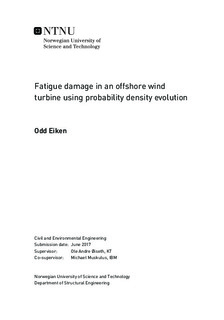Fatigue damage in an offshore wind turbine using probability density evolution
Master thesis
Permanent lenke
http://hdl.handle.net/11250/2455580Utgivelsesdato
2017Metadata
Vis full innførselSamlinger
Sammendrag
Due to large variability of the offshore environment, the load analysis of an offshore wind turbine is a complex task. It is normally performed in the time domain, by running Monte Carlo simulations. However, this is usually very time consuming due to the necessity of having long time series in order to sample events with low probability of happening. An alternative is to perform the analysis in the frequency domain. However, this method is only valid for linear systems, which makes it rather uncertain for fatigue damage results. This project aims to investigate an alternative approach based on probability evolution methods, which can obtain accurate results for linear, as well as non-linear systems. Nevertheless the methods is not very well known, and a drawback is that it can be numerically and computation challenging especially for high-dimensional problems. The benefits of the method is that it simulates all possible occurrences without generating a long signal in time domain.
This thesis describes the system as a probability density evolution (PDEM) with a cell mapping technique. The system is described as a Markov chain where the state transitions are described with a stochastic matrix. In order to keep all probability in the predefined states, a boundary is created at the edges of the displacement and velocity states. Different load cases have been tested for the method: a totally correlated harmonic load, completely uncorrelated white noise, and partial correlated autoregressive load. Furthermore the Markov chain approach is extended to peak to trough evolution describing a half cycle in a stochastic manner. This means that the damage calculations are based on probability density evolution rather than time domain simulation, and this new approach is therefore compared against already known theory.
The results show that the response probability distributions can be well estimated using the cell mapping technique for the investigated loads, and the Markov chain approach. The added boundaries do not disturb the final distribution, as long as the limits are not set too narrow. The damage intensity is found for a white noise spectrum, and the fatigue damage result seem to fit well with previously developed methods in time domain. This result is promising in terms of PDEMs ability of describing the stochastic system in a more precise and reliable manner.
